The-City-of-Xian(西安旅游景点美食英文介绍图解)
介绍西安(中英文版ppt)
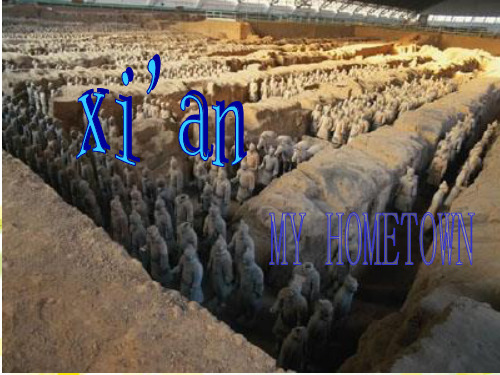
The historical city
General
Introduction
• Xi'an is a beautiful city with a long history. There is a long history of cultural relics, with beautiful natural scenery, there is a delicious snack of all kinds, there are many famous ancient buildings, such as the clay sulelievs, Banpo Museum, there are the best in the world, if there is a chance, you must come to Xi'an, I believe you will be very happy! 西安是一个具有悠久历史的美丽城市。有悠久的历史 文物,有着迷人的自然风光,还有着美味的各色小吃, 有很多著名的古老的建筑,如粘土sulelievs,半坡村 博物馆等,还有这世界之最,如果有机会你一定要来 西安,我相信你一定会非常开心的!
腊 汁 肉 夹 馍
Daguokui is traditional style pasta eating snacks for urban and rural residents in Shaanxi . For easy storage, eat a variety.
西安大雁塔英文介绍及西安小吃英文翻译[整理]
![西安大雁塔英文介绍及西安小吃英文翻译[整理]](https://img.taocdn.com/s3/m/7f0d4d45a88271fe910ef12d2af90242a895ab64.png)
西安大雁塔英文介绍及西安小吃英文翻译[整理]西安大雁塔英文介绍及西安小吃英文翻译[整理] 大雁塔英文介绍As the symbol of the old-line Xian, Big Wild Goose Pagoda is a well-preserved ancient building and a holy place for Buddhists. It is located in the southern suburb of Xian City, about 4 kilometers (2.49 miles) from the downtown of the city. Standing in the Da Ci'en Temple complex, it attracts numerous visitors for its fame in the Buddhist religion, its simple but appealing style of construction, and its new square in front of the temple. It is rated as a National Key Cultural Relic Preserve as well as an AAAA Tourist Attraction.This attraction can be divided into three parts: the Big Wild Goose Pagoda, the Da Ci'en Temple, and the North Square of Big Wild Goose Pagoda.Big Wild Goose PagodaOriginally built in 652 during the reign of Emperor Gaozong of the Tang Dynasty (618-907), it functioned to collect Buddhist materials that were taken from India by the hierarch Xuanzang.Xuanzang started off from Chang'an (the ancient Xian), along the Silk Road and through deserts, finally arriving in India, the cradle of Buddhism. Enduring 17 years and traversing 100 countries, he obtained Buddha figures, 657 kinds of sutras, and several Buddha relics. Having gotten the permission of Emperor Gaozong (628-683), Xuanzang, as the first abbot of Da Ci'en Temple, supervised the building of a pagoda inside it. With the support of royalty, he asked 50 hierarchs into the temple to translate Sanskrit in sutras intoChinese, totaling 1,335 volumes, which heralded a new era in the history of translation. Based on the journey to India, he also wrote a book entitled 'Pilgrimage to the West' in the Tang Dynasty, to which scholars attached great importance.First builtto a height of 60 meters (197 feet) with five stories, it is now 64.5 meters (211.6 feet) high with an additional two stories. It was said that after that addition came the saying-'Saving a life exceeds building a seven-storied pagoda'. Externally it looks like a square cone, simple but grand and it is a masterpiece of Buddhist construction. Built of brick, its structure is very firm. Inside the pagoda, stairs twist up so that visitors can climb and overlook the panorama of Xian City from the arch-shaped doors on four sides of each storey. On the walls are engraved fine statues of Buddha by the renowned artist Yan Liben of the Tang Dynasty. Steles by noted calligraphers also grace the pagoda.As for the reason why it is called Big Wild Goose Pagoda, there is a legend. According to ancient stories of Buddhists, there were two branches, for one of which eating meat was not a taboo. One day, they couldn't find meat to buy. Upon seeing a group of big wild geese flying by, a monk said to himself:'Today we have no meat. I hope the merciful Bodhisattva will give us some.' At that very moment, the leading wild goose broke its wings and fell to the ground. All the monks were startled and believed that Bodhisattva showed his spirit to order them to be more pious. They established a pagoda where the wild goose fell and stopped eating meat.Hence it got the name 'Big Wild Goose Pagoda'.Da Ci'en TempleDaCi'en Temple is the home of Big Wild Goose Pagoda. In 648, to commemorate the dead virtuous queen, royalty ordered the building of a temple named 'Ci'en' (Mercy and Kindness), for which the status and scale far exceeded all others. Today, with an area of 32,314 square meters (38,648.5 square yards), one seventh of the original area, itstill retains its grandeur.Before the temple, there stands a statue of hierarch Xuanzang, the meritorious hierarch. Walking on and across a small bridge, visitors will see the gates of the temple. With guarding lions, the temple seems stately for lions were said to function as talismans.Entering the temple you will see two buildings-Bell Tower in the east and Drum T ower in the west. Inside the Bell Tower hangs an iron bell 15 tons (14.76 gross tons) in weight. It was molded in 1548 in the Ming Dynasty (1368-1644). Along the central axis are arranged the Hall of Mahavira, Sermon Hall, Big Wild Goose Pagoda, and the Hall of Xuanzang Sanzang. In the Hall of Mahavira are three carved statues of Sakyamuni, and 18 arhats as well as Xuanzang. The Sermon Hall is where Buddhist disciples would listen to a sermon. A bronze statue of Amitabha is dedicated and a Buddha statue is collected by Xuanzang as oblation. The Hall of Xuanzang Sanzang is north of Big Wild Goose Pagoda. In this hall are Xuanzang's relic and a bronze statue of a seated Xuanzang. The inner wall is chiseled with murals depicting this hierarch's story. Renowned as the contemporary Dunhuang Buddhiststorehouse praised by UNESCO, it is the biggest memorial of Xuanzang.North Square of Big Wild Goose PagodaSurrounding Big Wild Goose Pagoda, the scenery is also quite charming, especially the square north of the Da Ci'en Temple. Covering about 110,000 square meters (131563 square yards) plus 20,000 square meters (23920.6 square yards) of water area, it holds many records: in Asia, it is the biggest Tang-culture square, the biggest fountain and waterscape square, and the largest-scale sculptures area. In the world, it has the most benches, the longest light-belt, and the largest-scale acoustic complex.The entire square is composed of waterscape fountains, a cultural square, gardensand tourist paths. There you can taste real Chinese culture and traditions and fully enjoy the truly attractive views. With reliefs on the theme of the prosperous Tang Dynasty, 200-meter-long (656-foot-long) sculpture groups, 8 groups of sculpted figures, 40 relievos on the land, and 22 styles of musical fountains, it has become a must-see when you visit Big Wild Goose Pagoda.西安小吃名称中英文常用地名钟楼 Bell tower 大雁塔 Big wild goose pagoda兵马俑 Emperor Qin's terra-cotta warriors and horses 回民街HUI minority street经典小吃羊肉泡馍 cruded pancake in mutton soup 凉皮 cold rice noodles 汤圆 sweet dumpling肉夹馍 chinese hamburger 中式早點烧饼 Clay oven rolls油条 Fried bread stick 韭菜盒 Fried leek dumplings 水饺 Boiled dumplings 蒸饺Steamed dumplings 馒头Steamed buns 饭团 Rice and vegetable roll 蛋饼Egg cakes咸鸭蛋Salted duck egg 豆浆Soybean milk 饭类稀饭Rice porridge 白饭Plain white rice 油饭Glutinous oil rice 糯米饭 Glutinous rice卤肉饭Braised pork rice 蛋炒饭Fried rice with egg 地瓜粥Sweet potato congee 面类馄饨面 Wonton & noodles刀削面Sliced noodles 麻辣面Spicy hot noodles麻酱面Sesame paste noodles 鴨肉面Duck with noodles鱔魚面 Eel noodles 乌龙面 Seafood noodles榨菜肉丝面Pork , pickled mustard green noodles牡蛎细面Oyster thin noodles 板条Flat noodles 米粉Rice noodles 炒米粉 Fried rice noodles 冬粉 Green bean noodle 汤类鱼丸汤 Fish ball soup 貢丸汤 Meat ball soup蛋花汤 Egg & vegetable soup 蛤蜊汤Clams soup牡蛎汤Oyster soup 紫菜汤Seaweed soup 酸辣汤 Sweet & sour soup 馄饨汤 Wonton soup 猪肠汤Pork intestine soup甜点糖葫芦T omatoes on sticks长寿桃 Longevity Peaches芝麻球 Glutinous rice sesame balls麻花 Hemp flowers冰类地瓜冰 Sweet potato ice 紅豆牛奶冰Red bean with milk ice八宝冰 Eight treasures ice 豆花Tofu pudding果汁甘蔗汁Sugar cane juice酸梅汁 Plum juice杨桃汁 Star fruit juice 青草茶Herb juice点心牡蛎煎 Oyster omelet臭豆腐 Stinky tofu (Smelly tofu)油豆腐Oily bean curd麻辣豆腐Spicy hot bean curd 虾片Prawn cracker 虾球 Shrimp balls春卷 Spring rolls蛋卷 Chicken rolls碗糕 Salty rice pudding筒仔米糕 Rice tube pudding 红豆糕 Red bean cake绿豆糕Bean paste cake糯米糕Glutinous rice cakes 萝卜糕Fried white radish patty芋头糕Taro cake 肉圆T aiwanese Meatballs水晶饺Pyramid dumplings 肉丸 Rice-meat dumplings 豆干 Dried tofu其他当归鸭Angelica duck槟榔 Betel nut火锅 Hot pot肉羹汤 Pork thick soup 鱿鱼汤Squid soup 花枝羹 Squid thick soup。
中国古都西安英文介绍(共30张PPT)
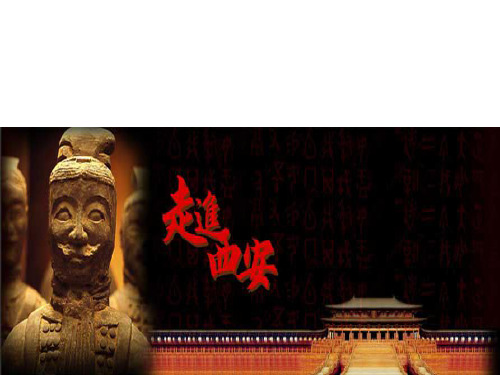
4.Shaanxi Liangpi
秦镇米皮
岐山擀面皮
Shaanxi Liangpi is famous throughout the country, has a long history of Shaanxi snacks. Shaanxi Ganmianpi has rigorous production process, seasoning quite good, cool and delicious, because "white, thin, light, soft, tendons, Hong" characteristics of the famous.
After payment, the customers can select the brown sugar, white sugar or orange flour and put it on the cake according to their tastes; soft, sweet, fragrant smell, the taste is very good..
Welcome to Xi’an
silk road
Xi'an is the eastern end of the Silk Road . The city has more than 3,100 years of history, and was known as Chang'an (traditional Chinese: 长安).
sanskrit( Buddhist scriptures )and buddhist
relics(佛像舍利) to design and built personally.
西安主要景点英文介绍(景点翻译)

1.华清宫;The Huaqing Pool is located in the Lintong District 30 km e ast to the urban area of Xian. With Mount. Li to its south and the Wei River to itsnorth, it boasts the natural hot springs. Thefavorable geographical condition and natural environment make it one of the cradles where ancient people settled and . It was also a favorite place for emperors to buildtheir palaces as a resort. Since ancient times, it has ever been a famous bathing and tourist destination.According to historical records and archeological the Huaqing Pool has a history of6000 years for the use of hot springs and a history of 3000 years of royal gardens. Over these years, the cultural relics excavated near the source of hot springs prove that over 6000 years ago primitive residents had used the hot spring. InWest Zhou, King Youwang o rdered the constructionof Li Palace on the site. Then the emperors of the following dynasties join in the line. After Emperor Xuan Zong ascended the throne, hecommanded the construction of Huaqing Palace ona large scale. The construction was built alongthe Lishan Mountains range, and the former spring well was designed into a pool. Roads were builtto reach the top of Lishan Mountain and one two-way road to Changan linked Huaqing Palacewith Daming Palace and Xingqing Palace in thecapital city. In the year 747 ., the new palacewas completed and emperor Xuan Zong named it Huaqing Palace. Because there are many h ot spring pools in the palace, it is also called HuaqingPool With the third peak of Lishan Mountain andthe source of hot springs on the axis and the hot springs as the center, the palace was laid out in four directions. This design, on the one hand,made a good use of the hot springs; on the other hand, it represented a precise and strict layout. Inside the palace, there were officials bureausand houses and hot pools. In addition, some recreational places such as the Rooster Fight Pit and Polo Field etc. for emperor Xuan Zong and Lady Yang were also available. At that time, thehistory of Huaqing Pool reached its climax.2.西安城墙Xi'an city wall is the Ming Dynasty the years inpolicy of Zhu Yuanzhang "high walls, wide accumulate grain, slow the guidance of kings"under, built on the basis of the Tang imperial. Completely around the "defense" strategy systemis greater than the thickness of the wall height, solid as a mountain, the top of the wall andpracticing sports can. Walls include moat, drawbridge, building gate, watchtower, is buildings, towers, fortresses, parapet, forts and other a series of military facilities. Since the completion of the wall after three major renovations. Longqing two years (1568), Shaanxi provincial governor Zhang Zhi presided over the restoration of Tucheng first into brick city;Qing Emperor Qianlong 46 years (1781), Shaanxi governor, Bi source host on the walls and towers were renovated; since 1983, in Shaanxi Provinceand Xi'an Municipal People's Government of thecity wall the large-scale renovation, construction has been the demolition of the east gate, north gate of the watchtower, on the SouthGate building, suspension bridge, and built around the park, so that this ancient buildingglow in the old style, has become a tourist attraction for visitors in Xi'an.3.西安碑林博物馆Forest of Stone Steles MuseumThe treasure house of ancient calligraphy andstone carving art of China, the Museum of Forest ofStone Tablets, which is located at the site of Confucian temple in SanXue Street, Xi’an. This museum was set up in 1087 and it collected morethan 3000 stone tablets from the Han dynasty through the Qing dynasty. The whole area consists of 3 parts: Confucian temple, exhibition of stone tablets and stone carvings.4.书院门there is a well-known street -Shuyuanmen A ncient Cultural Street. It is also named ‘the Arts St reet’, located on the eastern side of the southern gate of Xi'an. From the Bell Tower, walk along the South Avenue to the South Gate, you see a traditional archway on the east side of the road, that is Shyuanmen: he 200-m street is in the architectural style of the Ming and Qing dynasties. The street is under the south ancient city wall behind the Forest of Steles , both sides of the slab stone road are lined with buildingsin the Ming and Qing styles. Various crafts andarts are sold on this crowded street all year long. Historical relics, calligraphy, paintings, antiques, jewels, jade and folk art fine works are all tourist favorites.The name of Shuyuanmen, which means the gate of the academy o f classical learning, has its roots in Guanzhong Shuyuan (namely, the academy ofclassical learning in the area of central Shaanxi Plain. Guanzhong Shuyuan is the highest seat of learning in Shaanxi in Ming and Qing dynasty.Being the first-rate one in northwest area, it is also one of the four well-known academies of classical learning in China. The origin of Guangzhong Shuyuan also has an old story. It issaid that a high official called Feng Congwu, once submitted a written statement to the emperor, but only to be dismissed from office because he saidthe emperor was addicted to wine and women all day long without solving state affairs. Feng Congwuwent home and began to give lectures in Baoqing Temple. Later, the senior official Wang Keshou in Shaanxi province also joined him. From then on, thousands of people came here to listen to their lectures. So Guanzhong S huyuan was set up there. After nearly four or five centuries’ history, the old street near the south city wall has fallen into disrepair. Then being carefully planned and designed, it was rebuilt into an imitation ofancient business street with a style of Ming andQing dynasty in early 1990s.Today, Shuyuanmen is a place of tourist interest for the combination of both antiques and handicrafts. It is lined with row upon row ofmore than 100 diverse shops, such as shops for paintings, four treasures for study, seal or collection of ancient seals, etc. On the secondand third floor of the attic , there are many b lack tablets with golden-colored calligraphies on them, such as Wencuige, Zuishuxuan, Jukanzhai, Haoyuegong, etc. Modern handicrafts are the main items in this street, among which you could find the four treasures in the study, pottery figurine, calligraphy and paintings and imitation of the Terracotta Warriors and Horses , baccaro ware,seal cutting, carving,and so on. These all together made the street permeated with an elegant and cultural atmosphere.5.钟楼The Bell Tower Drum Tower and the City Well inXi’an The Bell Tower, a classical building with carved beams a nd painted rafters, has been servedas the symbol of Xi’an. It stands in the centerof the downtown area where the north street, thesouth street, the west street and the east street meet. And the tower house a huge bell which inancient times was use to strike the time every morning. This is how the tower got its name. nowit is an important historical monument in shaanxi Province. The Bell tower was first built in YingXiang temple in 1384 during the Ming dynasty. It was moved t o its present site in 1582 as a result of the city‘s expansion pro gram. Ladies and gentlemen, There is a story about the Bell Tower. It’s said that the first emperor of Ming dynasty , Zhu yuanzhang , he was born in a poor family. Both his parent died when he was young, and he had tolive a hard life. Later, he went to a temple tobecome a monk. When he ascended the throne, he was afraid of being deposed by someone of “real dragon”. Therefore, he gave orders to build bell tower all over the county to repress the “dragon spirits”. Xi’an has been the imperial capitalcity si nce ancient times. So the “dragonspirits ” must be very strong here. That’s why the bell tower in Xi’an was not only built earlier, but also bigger than the other ones inthe country. The base of the tower is 1, squaremeters in size, meters high and meters wide. It was laid with blue bricks all over. The wholebuilding is 36 meters above ground. It is a brick-and –wood structure. The eaves are supported by colored “dou gong” a traditional structural system in which brackets are used tojoin columns and crossbeams, the use of dou gong made the whole building firm and beautiful.6.小雁塔The Small Wild Goose Pagoda is located in theJianfu Temple. It’s one kilometer south from the downtown area .The Small Wild Goose Pagoda was built in Tang Dynasty.). It has fifteen storeysand it’s about forty-five meters above ground. In 1555, there was an earthquake in Huaxian of this province . As a result, the toptwo storeys of the pagoda were destroyed. Thepresent structure has only thirteen storeys .There is a story about the small wild goose pagoda . When Yi Jing appealed to the imperial court forfunds to build a pagoda, so as to preserve theBuddhist scriptures , the Emperor Li Xian askedthe Empress for advice as he often did . When s he heard of this, she ordered all the imperial concubines and court maids to donate money f or the construction of the pagoda .The ladies were so generous in their donation that there was stillmoney left over even after the project was completed.7.陕西省历史博物馆Shaanxi History Museum is located in the northwest of the Xi’an Wild Goose P agoda. It was built in 1983 and was open on June 20, 1991.Shaanxi History Museum is China’s first large-scale modern n ational museum; i t marks that China’s museum career has entered into a newdevelopment mileage. The Museum has the style of Tang dynasty buildings of “central palace hallwith four worship houses around” with orderly, harmonious, vigorous and grave construction, melting the national tradition, local characteristics and the spirit of time into anorganic whole. The Museum covers an area of 65,000 square meters. It has a building area of 55,600square meters, the cultural relic reservoir area of 8,000 square meters, and exhibition hall area of 11,000 square meters. Its collection of cultural relics reaches 370,000, dating from the simple stone that human u sed at the initial stage in ancient times down to all kinds implements insocial life before 1840; the time span covers more than one million years. The cultural relics arerich in number and types and have high grade andwide value, among w hich Shang bronze is exquisite; terracotta figurines of past dynasties are ofvaried types and postures; gold and silver wareof Han and Tang Dynasty is unique across the country; wall paintings of Tang tomb have noequals in this world. It is called a collection of variety of boutiques carnival.。
西安的美食英语介绍作文
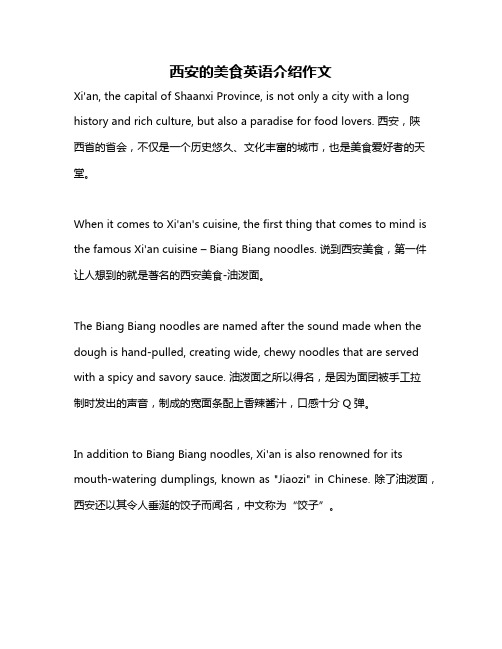
西安的美食英语介绍作文Xi'an, the capital of Shaanxi Province, is not only a city with a long history and rich culture, but also a paradise for food lovers. 西安,陕西省的省会,不仅是一个历史悠久、文化丰富的城市,也是美食爱好者的天堂。
When it comes to Xi'an's cuisine, the first thing that comes to mind is the famous Xi'an cuisine – Biang Biang noodles. 说到西安美食,第一件让人想到的就是著名的西安美食-油泼面。
The Biang Biang noodles are named after the sound made when the dough is hand-pulled, creating wide, chewy noodles that are served with a spicy and savory sauce. 油泼面之所以得名,是因为面团被手工拉制时发出的声音,制成的宽面条配上香辣酱汁,口感十分Q弹。
In addition to Biang Biang noodles, Xi'an is also renowned for its mouth-watering dumplings, known as "Jiaozi" in Chinese. 除了油泼面,西安还以其令人垂涎的饺子而闻名,中文称为“饺子”。
Xi'an's Jiaozi are typically filled with a mixture of pork, vegetables, and seasonings, wrapped in thin dough and then either boiled orpan-fried to perfection. 西安的饺子通常用猪肉、蔬菜和调味料混合制成馅料,包裹在薄薄的面团中,然后煮或煎至完美。
(优质课件)The City of Xian(西安旅游景点美食英文介绍图解)
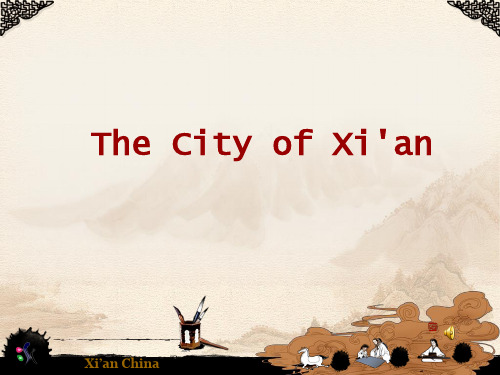
Ancient Tombs
• The Mausoleum of Yellow Emperor • The Qianling Mausoleum
• The Hanyang Mausoleum
6
Xi’an China
Ancient Architectures &Temples
• The Bell Tower
• The Small Wild Goose Pagoda
• The Drum Tower
• Famen Temple
• The Great Mosque in Huajue Lan
7
Xi’an China
Ancient Architectures &Temples
• The City Wall
•The Big Wild Goose Pagoda
19
Xi’an China
Thank You!
20
Xi’an China
3
Xi’an China
Museums
• Shaanxi History Museum • The Forest of Stone Tablets Museum
4
Xi’an China
Museums
• The Museum of Terracotta Warriors and Horses
5
Xi’an China
10
Xi’an China
Tourist Souvenirs
• Reproduction of The Qin Terracotta Figures
• Folk Paper-cuts
11
Xi’an China
The City of Xian(西安旅游景点美食英文介绍图解)
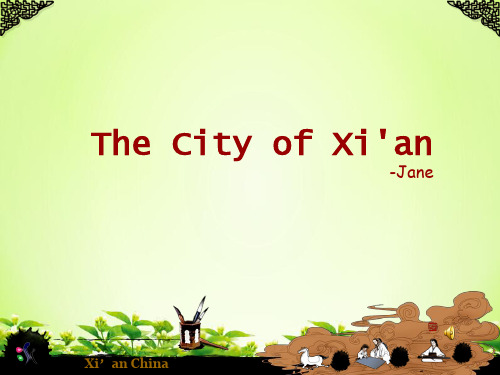
Thank You!
Xi’an China
Xi’an China
Museums
• Shaanxi History Museum • The Forest of Stone Tablets Museum
Xi’an China
Museums
• The Museum of Terracotta Warriors and Horses
Xi’an China
Xi’an China
Local Snacks
• Cold Noodles •Shredded Pancakes in Mutton or Beef Broth
Xi’an China
Local Snacks
• Zeng Gao • Hulutou • Others
Xi’an China
New sightseeings
• Tang Paradise
• Qujiang Pool Park
Xi’an China
New sightseeings
• The Big Wild Goose Pagoda Culture Square
Xi’an China
Shopping
• Xiaozhai • Century Ginwa Shopping Mall. • Kai Yuan Shopping Mall • Muslim Snack Street
Xi’an China
Tourist Souvenirs
• Rubbings of Stone Tablets
Xi’an China
Local Produce
• Lintong Fire-Crystal Persimmons • Lintong Pomegranate • Kiwi Fruit • Others
西安旅游景点英文介绍[精彩]
![西安旅游景点英文介绍[精彩]](https://img.taocdn.com/s3/m/1ab473fc0066f5335b81213a.png)
西安旅游景点英文介绍[精彩]大雁塔 Great Wild Goose Pagoda小雁塔 Small Wild Goose Pagoda秦始皇兵马俑博物馆Museum of Emperor Qinshihuang’s Tomb Figures of Soldiers and Horses 秦始皇陵 The Tomb of Emperor Qinshihuang黄帝陵 The Huangdi Tomb鼓楼 The Drum Tower钟楼 The Bell Tower西安城墙The Xi’an Circumvallation华清池 The Huaqing Pond乾陵 The Qian Tomb法门寺 The Famen Temple黄河壶口瀑布 The Huanghe Hukou Waterfall大唐芙蓉园 Lotus palace of Tang DynastyTerra-cotta warriors -- Qin Dynasty 秦始皇兵马俑The Silk Road 丝绸之路Big and Little Goose Pagodas 大小雁塔Shaanxi is one of civilized important , all together China headstream, as far back as havingLantian Man to grow work here right away in the front for 1000000 years, starting from the 11thcentury B.C., successively have 13 in history dynasty found acapital here. Shaanxi Province fieldof being that our country cultural relics and historic sites gathers together , name of having "the natural history museum ": Acient Chang An county City historical remains, are known as eighthShaanxi not only cultural relics and historic sites is a lot of ,but also natural scene isbeautiful: Have precipitous West Hua Mountain and Lin Tong Mt. black horse intelligent and elegant;Huanghe River kettle mouth waterfall having rapids to surge; Still have the organism's habitstourist area giving first place to protecting a giant panda waiting for a rare animal. Not onlynorthern Shaanxi highland be Chinese revolution base area , but also be Shaanxi folk custom localmanners and feelings headstream: Shaanxi opera loud and sonorous , vehement gong and drum ,consummate paper-cut and extremely rich life breath peasant painting etc. , the sight havingattracted more and more many attention's all with it's culture thick and heavy bottom rhyme anddistinctive loess amorous feeling.largest in the world miracle Qin Shi Huang's Buried SculptureLegion , grand grand sight 72emperors mausoleum big or small, ... Distant vast China civilization makes everyone first thepeople who arrives at Shaanxi not excavate heart profundity meditating on the past conscientiouslyXi'an, the capital city of Shaanxi Province, is located in thecentral area of northwest China. It sits on an ancient site and there are layers of cities of different names beneath and around the city. The land is fertile, renewed yearly by the silt from the Yellow River. Since the age of the nomads, people have settled in this rich land to take advantage of the relatively flat landscape, plentiful water, and ease of travel.As one of the ancient capitals of China, it served 12 imperial dynasties for over a thousand years. Today, Xi'an is a treasure house of historical relics and cultural heritage.Xian was called Chang'an in the Han Dynasty, which literally means a place of permanent peace. The city was renamed Xi'an in 1369. From the 11 century B.C. onwards, Xi'an was the capital city of 11 successive dynasties, including the Western Zhou, the Qin, the Han, the Sui and the Tang dynasties; in addition Xi'an had also served as the capital of two peasant regimes, under the rule of Huang Chao and Li Zicheng. The city's capital status lasted for 1,608 years.Indeed, Xi'an has made an unparalleled contribution to the history and culture of China. For more than a millennium, it was the stage on which the histories of more than a dozen Chinese dynasties unfolded.Every move and every action originating from Xi'an had a far-reaching influence on the course of China's social development.It is where, three thousand years ago, the aristocrats of the Zhou dynasty instituted rites and composed music, while offering libations to gods and ancestors and feasting themselves out of bronze utensils. It is where, two thousand years ago, the Qin army eliminated six rival states and initiated the first centralized autocracy, which started off a 20 century-long imperial history in China and exerted a far-reaching influence on subsequent dynasties.Xi'an was the starting point of the famous Silk Road when the pathto wealth emerged during the Han dynasty; and reached its historical apex during the flourishing and prosperous Tang Dynasty 1300 years ago. Many historians believe that the Chang'an of the Tang Dynasty was one of the largest cities in the world; and for thousands of international traders and merchants, Chang'an was a promising land full of fortune.The English word "China" is a transliteration of the Chinese ideogram meaning "Qin". Those who live in and around Xi'an are direct descendents of the Qin people. Emperors chose Xi'an as their capital partly because of its fertile land and sufficient water supply andpartly because it was militarily formidable, because of the mountains that skirted it. It is precisely because of its somewhat isolated location that Xi'an was able to preserve so much of its history and culture to this day.The local dialect of Xi'an and the Guanzhong Plain is reflective of the rhythm and timbre of archaic Chinese. Weddings, funerals, celebrations, diet, and social etiquette are all evocative of the social mores and traditions of the dynasties of the Zhou, Qin, Han and Tang.So it's no wonder that some say Xi'an is the historical center of China today. An ancient philosopher once mused that all those seeking the truth should go to China; and a contemporary philosopher consolidated it with that no visit to China is complete without a journey to Xi'an.Today, the rich historical and cultural heritage of Xi'an is visible through a wealth of cultural relics, museums, and historical sites including the world-famous terracotta warriors of Emperor Qin Shi Huang. The flat plane on the city's outskirts is strewn with the tomb mounds of emperors, empresses, aristocrats, ranking officials and scholars from ancient times. The remains of past civilizations are evidence of every major epoch in China's half a million year history. The history apparent in Xian is so ancient and continuous that the city has no parallel anywhere as a cultural site.In Xi'an you will find yourself in a world of amazing artifacts. You can visit the sites once inhabited by China's primitive people; admire the bronze wares manufactured in the Bronze Age; wander through the city ruins of the Qin, Han, Sui and Tang Dynasties; imagine the hustle and bustle of the old Oriental metropolis; you can go to explore theimperial tombs of the Qin, Han and Tang Dynasties, testimony to thepervasive power of the feudal ruling class; you can also wander through temples and pagoda courtyards, tracing vestiges of the Silk Road; and study stone inscriptions to appreciate Chinese calligraphy. Not least, the site of the spectacular army of terracotta warriors and horses from the tomb of China's First Emperor, Qin Shihuang, is amust-see in your trip in Xi'an.0. 西安地理位置1. Xi'an lies on the Guanzhong Plain in central China, on a flood plain createdby the eight surrounding rivers and streams. The Wei River provides potable waterto the city.2. The city borders the northern foot of the Qinling Mountains to the south, andthe banks of the Wei River to the north. Hua Shan, one of the five sacred Taoistmountains, is located 100 km away to the east of the city.Guanzhong Plain, which is located behind Xiao Pass and Hangu Pass, connects Long Plain and Shu Plain. Land of thousands miles and rich in harvest can be found here, as if this place is belongs to the nation of the heaven.关中左崤函, 右陇蜀, 沃野千里, 此所谓金城千里, 天府之国也《史记?留侯世家》)1.秦始皇兵马俑The Terracotta Army or the "Terra Cotta Warriors and Horses", is a collection of terracotta sculptures depicting the armies of Qin Shi Huang, the first Emperor of China. It is a form of funerary art buried with the emperor in 210–209 BC and whose purpose was to protect the emperor in his afterlife, and to make sure that he had people torule over.The figures, dating from 3rd century BC, were discovered in 1974 by some local farmers in Lintong District, Xi'an, Shaanxi province.The figures vary in height according to their roles, with thetallest being the generals. The figures include warriors, chariots and horses. Current estimates are that in the three pits containing the Terracotta Army there were over 8,000 soldiers, 130 chariots with 520 horses and 150 cavalry horses, the majority of which are still buried in the pits near by Qin Shi Huang's mausoleum. Other terracotta non-military figures were also found in other pits and they include officials, acrobats, strongmen and musicians.2.大雁塔As the symbol of the old-line Xian, Big Wild Goose Pagoda is a well-preserved ancient building and a holy place for Buddhists. It is located in the southern suburb of Xian City, about 4 kilometers from the downtown of the city. Originally built in 652 during the reign of Emperor Gaozong of the Tang Dynasty , it functioned to collect Buddhist materials that were taken from India by the hierarch Xuanzang.3.饺子宴When traveling in Xian, one pleasure you should not miss is the Dumpling Banquet. Dumpling or Jiaozi in Chinese is a traditional and still popular food in China. A banquet will feature nearly 20 varieties that are stuffed and cooked using a delicious assortment of vegetables, meats and seafood. These dumplings feature harmony between a variety of tastes and textures for an enjoyable eating experience.肉夹馍、臊子面等美食4.华清宫In Tang dynasty , emperor Xuan Zong and his favorite concubine lady Yang used to make their home here since it was cold in the capital Chang’an .。
西安美食介绍英语作文
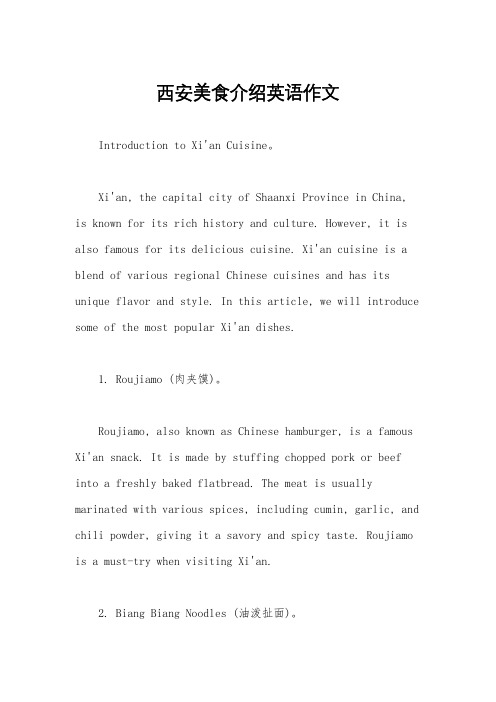
西安美食介绍英语作文Introduction to Xi'an Cuisine。
Xi'an, the capital city of Shaanxi Province in China,is known for its rich history and culture. However, it is also famous for its delicious cuisine. Xi'an cuisine is a blend of various regional Chinese cuisines and has its unique flavor and style. In this article, we will introduce some of the most popular Xi'an dishes.1. Roujiamo (肉夹馍)。
Roujiamo, also known as Chinese hamburger, is a famous Xi'an snack. It is made by stuffing chopped pork or beef into a freshly baked flatbread. The meat is usually marinated with various spices, including cumin, garlic, and chili powder, giving it a savory and spicy taste. Roujiamo is a must-try when visiting Xi'an.2. Biang Biang Noodles (油泼扯面)。
Biang Biang Noodles are a type of hand-pulled noodles that are unique to Xi'an. The noodles are thick and wide, and they are served with a spicy sauce made from chili oil, vinegar, and garlic. The name "biang biang" comes from the sound the noodles make when they are slapped against the table during the preparation process. Biang Biang Noodles are a hearty and satisfying dish.3. Yang Rou Pao Mo (羊肉泡馍)。
西安旅游美食英文介绍

hukou waterfalls 壶口瀑布
Qinling 秦岭
Sunset 日落
Part two:foods
Do you know what kinds of foods in xi 'an? What is your favorite food about xi 'an?
Pita Bread Soaked in Lamb Soup 羊肉泡馍
Today i just want to tell something of it .
Part three :universty
Thank you Welcome to xi 'an city !!!
First part:travel
We all know that xi ‘an is an ancient city, there are 13 dynasties established their capitals here, xi ‘an is famoused for its ancient history and culture. But in addition to the rich historical heritage, xi ’an also is known as its beautiful natural scenery and delicious gourmet relish(美食), below I will give you three parts to introduce my hometown - xi 'an.
Chinese hamburger 肉夹馍
Cold noodle 凉皮
Eight delicacies rice 八宝稀饭
中国古都西安英文介绍(共30张PPT)

Steamed dumplings
Noodle with pork
cruded pancake in mutton soup Parsley
The Terra Cotta Warriors And horses
The Terra Cotta Warriors And horses is regarded as one of the eight greatest wonders in the world,and a sight not to be missed by any visitor to China.In 1987,it was listed as one of the world cultural heritages by UNESCO.As one of the most famous scenic spots in China,it attracts lots of tourists both at home and from abroad.The museum covers an area of 16,300 square meters,and is divided into three sections:No.1 Pit (坑 ),No.2 Pit,No.3 Pit respectively.They were tagged in the order of their discoveries.There are columns(塔器)of soldiers at the front,followed by war chariots(战车) at the back.
kilometers east of Xi'an, about 3 hours from the city centre. There are five peaks that make up the mountain: Cloud Terrace Peak (North Peak, 1613m)(北云台峰 ), Jade Maiden Peak (Middle Peak, 2042m)(中玉女 峰 ), Sunrise Peak (East Peak, 2100m)(东朝 阳峰 ), Lotus Peak (West Peak, 2038m) (西 莲花峰 )and Landing
西安的景点和美食英文介绍

西安的景点和美食英文介绍Xi'an Attractions and Foods1. Terracotta Warriors of Qin Shi Huang - A world-famous ancient military heritage, these life-size terracotta warriors and horses were discovered in 1974 during the construction of a large mausoleum near Xi'an, Shaanxi Province. Dating back to the Qin Dynasty (221-206 BC), the statues are a masterpiece of Chinese sculpture and one of the most important cultural relics in China.2. Big Wild Goose Pagoda - This pagoda, which dates back to the Tang Dynasty (618-907), is one of the most famous pagodas in China. It is located in the center of the city and can be seen from anywhere in Xi'an.3. Ancient City Wall - The city wall of Xi'an is one of the largest and best-preserved ancient city walls in the world. It was first built during the Western Zhou Dynasty (1046-771 BC) and was completed during the Ming Dynasty (1368-1644).4. Shaanxi History Museum - This museum is one of the largest provincial museums in China. It is dedicated to displaying the history and culture of Shaanxi Province and features collections from various periods of Chinese history.5. Huaqing Pool - This is a wenquan near Xi'an that has been used byemperors and their retinues for centuries. The hot springs are believed to have curative properties, and the surrounding scenery is beautiful.1. Roujiamo - This is a popular snack in Xi'an that consists of a piece of bread stuffed with minced meat. The meat is seasoned with various spices and is soft and moist, while the bread is crispy and fragrant.2. Yangrou Pamu - This is a famous specialty snack in Xi'an made from lamb meat that has been shredded and then boiled in mutton fat and water until it reaches a porridge-like consistency. It is served with a large amount of sliced fresh garlic and is eaten by dipping the bread into the soup.3. Liangpi - This refreshing snack is made from a starch-based noodle that is prepared with a cold sauce that includes vinegar, soy sauce,sesame oil, mustard, ginger, garlic, sugar, and water. The texture of the noodles is smooth and slippery, while the taste is sour and spicy.4. Rouyu Huolatan - This is a local favorite that consists of meatballs made from ground pork mixed with flour, eggs, and seasonings, then simmered in a richly flavored lamb broth. The resulting dish is a combination of tender meatballs and rich, hearty soup that is both nourishing and satisfying.。
英文最喜欢的城市西安PPT课件
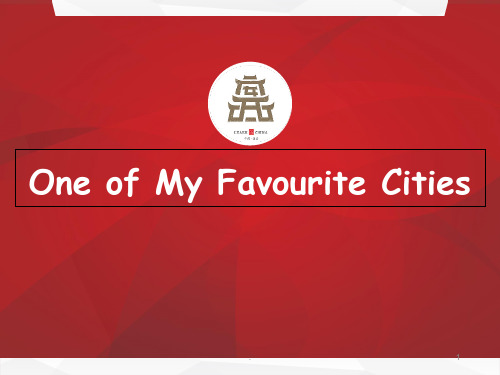
snacks kingdom
Mutton paomo:crumbled unleavened bread soaked in mutton stew Roujiamo:Griddle steamed bread with mincemeat fillings Huiminjie:a good place to eat these snacks
.
4
the xi an city
One of the oldest cities in China, Xi'an is the oldest of the Four Great Ancient Capitals, having held the position under several of the most important dynasties in Chinese history,including Western Zhou(西周), Qin(秦), Western Han(西汉), Sui(隋), and Tang(唐).
Sui dynasty Tang Dynasty.
In 202 BC Han dynasty established
.
7
03
Tourism
.
8
tourism
The number of travelers is often greater during Summer (May–August), although the most pleasant season for visiting Xi'an is Autumn.
A 6,500-year-old Banpo Neolithic
village was discovered in
西安美景和美食介绍英文版
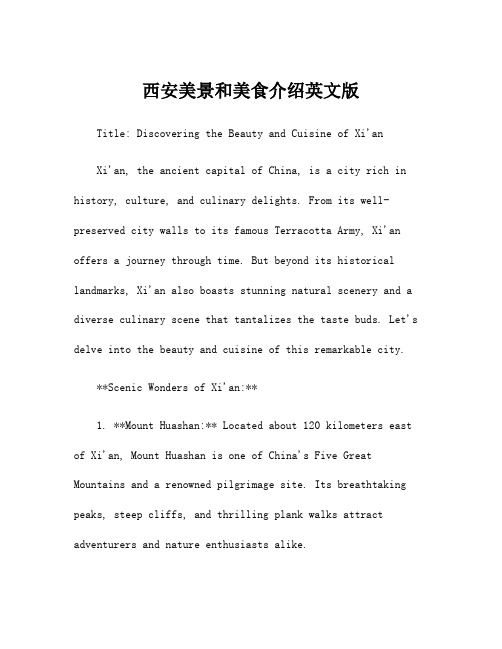
西安美景和美食介绍英文版Title: Discovering the Beauty and Cuisine of Xi'anXi'an, the ancient capital of China, is a city rich in history, culture, and culinary delights. From its well-preserved city walls to its famous Terracotta Army, Xi'an offers a journey through time. But beyond its historical landmarks, Xi'an also boasts stunning natural scenery and a diverse culinary scene that tantalizes the taste buds. Let's delve into the beauty and cuisine of this remarkable city.**Scenic Wonders of Xi'an:**1. **Mount Huashan:** Located about 120 kilometers east of Xi'an, Mount Huashan is one of China's Five Great Mountains and a renowned pilgrimage site. Its breathtaking peaks, steep cliffs, and thrilling plank walks attract adventurers and nature enthusiasts alike.2. **Huaqing Pool:** Nestled at the foot of Mount Li, Huaqing Pool is a historical hot spring resort with a picturesque setting. Its tranquil pools and landscaped gardens have been enjoyed by emperors and concubines for centuries.3. **Qinling Mountains:** To the south of Xi'an lies the majestic Qinling Mountains, known for their lush forests, diverse wildlife, and scenic hiking trails. Nature lovers can explore its hidden valleys, cascading waterfalls, and ancient temples.4. **Giant Wild Goose Pagoda:** Standing tall in the southern part of the city, the Giant Wild Goose Pagoda is a symbol of Xi'an's rich Buddhist heritage. Visitors can climb to the top for panoramic views of the city and enjoy the serene atmosphere of its surrounding gardens.**Culinary Delights of Xi'an:**1. **Xi'an Dumplings (Jiaozi):** A trip to Xi'an is incomplete without sampling its famous dumplings. Stuffedwith savory fillings such as minced pork, beef, or vegetables, and served with a variety of dipping sauces, Xi'an dumplings are a culinary delight not to be missed.2. **Roujiamo (Chinese Hamburger):** Often referred to as "Chinese hamburgers," roujiamo consists of tender, slow-cooked meat stuffed inside a freshly baked bun. This popular street food is both flavorful and satisfying, making it a favorite among locals and tourists alike.3. **Biangbiang Noodles:** Named after the sound of the noodles being slapped against the table, biangbiang noodlesare a staple of Xi'an cuisine. These wide, hand-pullednoodles are typically served in a savory broth with vegetables, meat, and spicy chili oil, creating a hearty and comforting dish.4. **Yangrou Paomo (Lamb Soup with Bread):** Originating from the Muslim quarter of Xi'an, yangrou paomo is a hearty soup made with tender lamb, vegetables, and torn pieces of flatbread. Diners can customize their soup by adding condiments such as chili paste, garlic, and cilantro,creating a flavorful and aromatic meal.**Exploring Xi'an's Culture and Cuisine:**1. **Muslim Quarter:** Wander through the bustlingstreets of Xi'an's Muslim Quarter, where the aroma of grilled kebabs and freshly baked bread fills the air. Sampletraditional snacks such as persimmon cakes, sticky rice balls, and fried pancakes as you immerse yourself in the vibrant sights and sounds of this lively neighborhood.2. **Food Markets:** Dive into Xi'an's bustling food markets, where vendors sell an array of fresh produce, spices, and culinary delights. From exotic fruits and aromatic herbsto handmade noodles and sweet treats, these markets offer a sensory feast for food enthusiasts.3. **Cooking Classes:** Learn the art of Xi'an cuisine by taking a cooking class with a local chef. From mastering the art of noodle-making to perfecting the spice blend for savory dishes, these hands-on experiences provide insight into the rich culinary traditions of Xi'an.4. **Teahouses:** Relax and unwind in one of Xi'an's traditional teahouses, where you can sip fragrant teas and sample delicate snacks while enjoying live music and performances. These tranquil oases offer a glimpse into China's tea culture and provide a peaceful retreat from the hustle and bustle of the city.In conclusion, Xi'an captivates visitors with its blend of natural beauty, historical treasures, and mouthwatering cuisine. Whether you're exploring ancient landmarks orsavoring traditional dishes, Xi'an offers a truly unforgettable experience that delights all the senses.。
介绍西安旅游景点和美食的英语作文
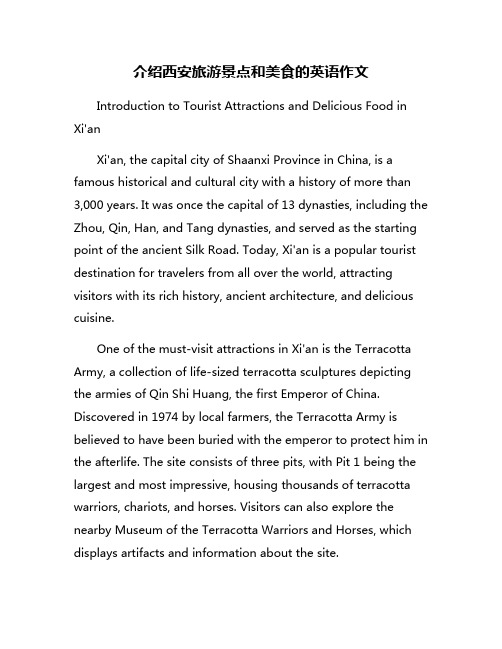
介绍西安旅游景点和美食的英语作文Introduction to Tourist Attractions and Delicious Food inXi'anXi'an, the capital city of Shaanxi Province in China, is a famous historical and cultural city with a history of more than 3,000 years. It was once the capital of 13 dynasties, including the Zhou, Qin, Han, and Tang dynasties, and served as the starting point of the ancient Silk Road. Today, Xi'an is a popular tourist destination for travelers from all over the world, attracting visitors with its rich history, ancient architecture, and delicious cuisine.One of the must-visit attractions in Xi'an is the Terracotta Army, a collection of life-sized terracotta sculptures depicting the armies of Qin Shi Huang, the first Emperor of China. Discovered in 1974 by local farmers, the Terracotta Army is believed to have been buried with the emperor to protect him in the afterlife. The site consists of three pits, with Pit 1 being the largest and most impressive, housing thousands of terracotta warriors, chariots, and horses. Visitors can also explore the nearby Museum of the Terracotta Warriors and Horses, which displays artifacts and information about the site.Another popular tourist spot in Xi'an is the Ancient City Wall, a well-preserved fortification that encircles the city center. Built during the Ming Dynasty, the wall stretches for 13.7 kilometers and is one of the best-preserved city walls in China. Visitors can rent a bicycle or walk along the wall to enjoy panoramic views of the city and its surroundings. There are also four gates along the wall, each with its own unique characteristics and history.For those interested in history and culture, the Shaanxi History Museum is a must-visit destination in Xi'an. The museum houses a vast collection of artifacts and relics from various dynasties, including bronze wares, pottery, and ancient weapons. The museum's architecture is also noteworthy, with its traditional Chinese style and grand courtyard.In addition to its historical attractions, Xi'an is also famous for its delicious cuisine. One of the most popular dishes in Xi'an is the "biang biang" noodles, which are thick, hand-pulled noodles topped with savory sauces and meat. Another must-try dish is the "rou jia mo," a type of Chinese hamburger made with minced meat and stuffed in a flatbread. Xi'an is also known for its dumplings, with variations such as steamed, boiled, andpan-fried dumplings available.Overall, Xi'an offers a unique blend of history, culture, and cuisine that attracts travelers from all over the world. Whether you are interested in exploring ancient sites or trying new and delicious foods, Xi'an has something to offer for everyone. Plan your trip to Xi'an today and experience the wonders of this ancient city for yourself!。
西安美食和名胜英语作文
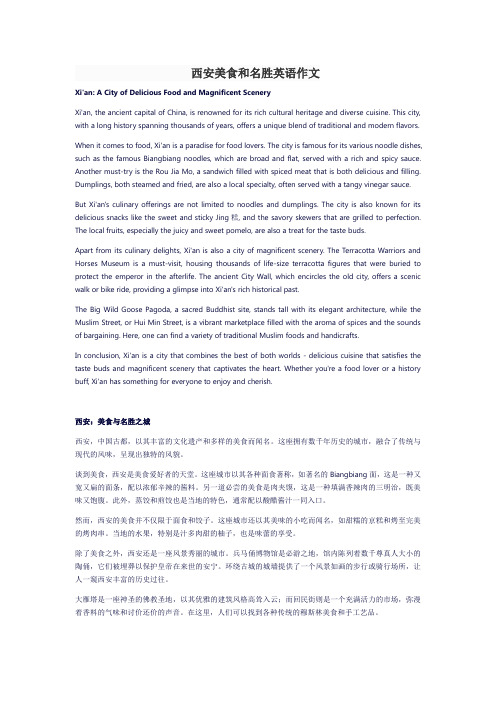
西安美食和名胜英语作文Xi'an: A City of Delicious Food and Magnificent SceneryXi'an, the ancient capital of China, is renowned for its rich cultural heritage and diverse cuisine. This city, with a long history spanning thousands of years, offers a unique blend of traditional and modern flavors.When it comes to food, Xi'an is a paradise for food lovers. The city is famous for its various noodle dishes, such as the famous Biangbiang noodles, which are broad and flat, served with a rich and spicy sauce. Another must-try is the Rou Jia Mo, a sandwich filled with spiced meat that is both delicious and filling. Dumplings, both steamed and fried, are also a local specialty, often served with a tangy vinegar sauce.But Xi'an's culinary offerings are not limited to noodles and dumplings. The city is also known for its delicious snacks like the sweet and sticky Jing糕, and the savory skewers that are grilled to perfection. The local fruits, especially the juicy and sweet pomelo, are also a treat for the taste buds.Apart from its culinary delights, Xi'an is also a city of magnificent scenery. The Terracotta Warriors and Horses Museum is a must-visit, housing thousands of life-size terracotta figures that were buried to protect the emperor in the afterlife. The ancient City Wall, which encircles the old city, offers a scenic walk or bike ride, providing a glimpse into Xi'an's rich historical past.The Big Wild Goose Pagoda, a sacred Buddhist site, stands tall with its elegant architecture, while the Muslim Street, or Hui Min Street, is a vibrant marketplace filled with the aroma of spices and the sounds of bargaining. Here, one can find a variety of traditional Muslim foods and handicrafts.In conclusion, Xi'an is a city that combines the best of both worlds - delicious cuisine that satisfies the taste buds and magnificent scenery that captivates the heart. Whether you're a food lover or a history buff, Xi'an has something for everyone to enjoy and cherish.西安:美食与名胜之城西安,中国古都,以其丰富的文化遗产和多样的美食而闻名。
西安著名景点英文简介

西安及周边出名景面英语简介之阳早格格创做西安几大出名旅游景面介绍(英文)大雁塔 Great Wild Goose Pagoda小雁塔 Small Wild Goose Pagoda秦初皇戎马俑专物馆Museum of Emperor Qinshihuang’s Tomb Figures of Soldiers and Horses秦初皇陵 The Tomb of Emperor Qinshihuang饱楼 The Drum Tower钟楼 The Bell Tower西安乡墙 The Xi’an Circumvallation华浑池 The Huaqing Pond法门寺 The Famen Temple黄河壶心瀑布The Huanghe Hukou Waterfall 大唐芙蓉园Lotus palace of Tang Dynasty 大雁塔Xi'an: Big Wild Goose Pagoda (Dayanta)The Big Wild Goose Pagoda (Dayan Ta),is a Buddhistpagoda built in 652 AD during the Tang Dynasty and originally had five stories.The original construction of rammed earth with a stone exterior facade eventually collapsed five decades later but was rebuilt by Empress Wu Zetian in 704AD who added five more stories. A massive earthquake in 1556 heavily damaged the pagoda and reduced it by three stories to its current height ofseven stories One of the pagoda's many functions was to hold sutras and figurines of the Buddha that were brought to China from Indiaby Xuanzang, a famous Chinese Buddhist monk, scholar, traveler, and translator.Xuanzang is a prominent Buddhist figure mostly known for his seventeen year overland trip to India and back, which is recorded in detail in his autobiography and a biography, and which provided the inspiration for the epic novel “Journey to the West”. The pagoda is built on the premises of the Temple of Great Maternal Grace (Da Ci'en), originally built in 589 AD and then rebuilt 647 AD by the Tang Emperor Gaozong in memory of his mother EmpressWende. Before the gates of the temple stands a statue of Xuanzang.大雁塔北广场North Square of Big Wild Goose Pagoda Surrounding Big Wild Goose Pagoda, the scenery is also quite charming, especially the square north of the Da Ci'en Temple. Covering about 110,000 square meters (131563 square yards) plus 20,000 square meters (23920.6 square yards) of water area, it holds many records: in Asia, it is the biggest Tang-culture square, the biggest fountain and waterscape square, and the largest-scale sculptures area. In the world, it has the most benches, the longest light-belt, and the largest-scale acousticcomplex. The entire square is composed of waterscape fountains, a cultural square, gardens and tourist paths. There you can taste real Chinese culture and traditions and fully enjoy the truly attractive views. With reliefs on the theme of the prosperous Tang Dynasty, 200-meter-long (656-foot-long) sculpture groups, 8 groups of sculpted figures, 40 relievos on the land, and 22 styles of musical fountains, it has become a must-see when you visit Big Wild Goose秦初皇戎马俑The Museum of Qin Terra-cotta Warriors and HorsesOne of the most significant archaeological finds in the world, this 16,300-square-meter excavation reveals more than 7,000 life-size terracotta figures of warriors and horses arranged in battle formations. (3 pits) The terracotta warriors and horses, created about 2,200 years ago, were found in 1974 on the east side of the tomb of the First Emperor Qin Shihuang (259 BC - 210 BC) near Xi'an. Emperor Qin Shihuang had Ying as his surname and Zheng as his given name. In 221 B.C., when he unified the whole country, named himself Shihuang Di and carried on the hereditary system. To protect against harassment by the Hun aristocrats. Emperor Qin Shihuang ordered the Great Wall be built.钟楼The Bell Tower (Zhonglou)Centrally located on the "Four Main Roads" junction is the BellTower, of Xi'an. The original CityBellTower was constructed in 1582 and situated in the west, but on its reconstruction in 1739, the tower was relocated to its present site. A Ming dynasty bell weighing approximately 14.76 tons hangs in the tower, but no longer chimes to inform residents of the time of day. Visitors have the chance to inspect up-close a number of smaller bells. Although the site itself is more of a landmark than an attraction, it is frequently enlivened with local performances. Visitors interested in local music should visit the site in the morning and early afternoon. Originally, the tower had a number of entrances, but today, it only has one accessible entrance located on Bei Dajie close to the Admission Ticket Office.饱楼Xi'an: DrumTower (Gulou)The DrumTower was built in 1380 during the early Ming Dynasty, and got its name from the hugedrum located within the building. In contrast to the BellTower ,where bell was stricken at dawn, drum was beat at sunset to indicate the end ofthe day. There are twenty-four drums in the northand south sides of the DrumTower . These drums standfor the Twenty-four SolarTerms, a form of weather calendar created by theChinese in order to guide the agricultural production.西安乡墙The Xi’an CircumvallationThe Xi’an Circumvallation site is located at the center of xi’an city with the form of a rectangular. The circumvallation, with its wall height of 12 meters, bottom width of 18 meters and top width of 15 meters, consists of 4 city gates: changle gate to the east, anding gate to the west, yongling gate to the south and anyuan gate to the north. Its east wall has the length of 2590 meters, west wall of 2631.2 meters, south wall of 3441.6 meters and north wall of 3241 meters. It was constructed on the basis of the tang imperial city and under the strategic consideration of defense. The thickness of the wall is larger than its height and is very solid that cars can run on it. The existing circumvallation was built during 1373-1378 with the history of more than 600 years. It is one of the most famous wall construction in China’s history after the middle ages as well as the most preserved ancient one in China.小雁塔Small Wild Goose PagodaThe Small Wild Goose Pagoda, sometimes Little Wild Goose Pagoda (Chinese: 小雁塔; pinyin: Xiǎoyàn Tǎ), is one of two significant pagodas in the city of Xi'an, China, the site of the oldHan and Tang capital Chang'an. The other notable pagoda is the Giant Wild Goose Pagoda, originally built in 652 and restored in 704. The Small Wild Goose Pagoda was built between 707–709, during the Tang Dynasty under Emperor Zhongzong of Tang (r 705–710). The pagoda stood 45 m (147 ft) until the 1556 Shaanxi earthquake. The earthquake shook the pagoda and damaged it so that it now stands at a height of 43 m (141 ft) with fifteen levels of tiers.[1] The pagoda has a brick frame built around a hollow interior, and its square base and shape reflect the building style of other pagodas from the era.[1] During the Tang Dynasty, the Small Wild Goose Pagoda stood across a street from its mother temple, the Dajianfu Temple. Pilgrims brought sacred Buddhist writings to the temple and pagoda from India, as the temple was one of the main centers in Chang'an for translating Buddhist texts.[1] The temple was older than the pagoda, since it was founded in 684, exactly 100 days after the death of Emperor Gaozong of Tang (r. 649–683).[1] Emperor Zhongzong had donated his residence to the building of a new temple here, maintaining the temple for 200 monks in honor of his deceased father Gaozong.[1] The temple was originally called the Daxianfusi or Great Monastery of Offered Blessings by Zhongzong, until it was renamed Dajianfusi byEmpress Wu Zetian in 690.华浑池Huaqing Hot SpringsHuaqing Hot Springs, also known as HuaqingPalace, is a well-known historic site and an AAAAA tourist attraction of China. It gets its fame for being the place where the romantic story of Emperor Tangxuanzong of Tang Dynasty (618-907) and his beloved Yang Guifei (or Concubine Yang) took place. As a matter of fact, the site had been as an imperial palace for emperors' short stays away from the capital for more than 3000 years. Emperors of Zhou, Qin, Han, Sui and Tang dynasties spent the winter at this place every year. Emperor Zhouyouwang of Western Zhou Dynasty (1046BC-771BC) is said to be the first emperor who ordered to build a palace at the site. In the following dynasties, the palace was repaired and expanded for several times, given the name of "Hot Spring Palace" and finally denominated "HuaqqingPalace" by Emperor Tangxuanzong. The palace was constructed above hot springs, hence the site is also called "Huaqing Hot Springs".法门寺The Famen TempleFamenTemple, renowned for storing the veritable Finger Bone of the Sakyamuni Buddha, is located in Fufeng County of Shaanxi Province. FamenTemple was established in theEastern Han Dynasty (25--220) for spreading Buddhism. The most representative structures in the temple are the Famen Temple Pagoda and FamenTempleMuseum. Many royal treasures and jewelry were found here. But why? FamenTemple was the royal temple during the Sui Dynasty (581-618) and Tang Dynasty. Emperors in Sui and Tang believed that enshrining and worshiping the bone of Sakyamuni would bring richness and peace to the land and its people. So an offering of treasure to the finger bone was made, which was housed in the UndergroundPalace.壶心瀑布Hukou WaterfallThe Hukou waterfall on the Huanghe River west of Jixian County, Shanxi, is formed when the river flows to the Hukou Mountains on the Shanxi-Shaanxi border and its 250-meter-wide bed, sandwiched between the canyons on its banks, abruptly narrows into a trough 50 meters wide and 30 meters deep and falls down into a big stone-strewn pool. The section of the river here is like the mouth of a water-flash. Hence the name of the waterfall, which means “Flask Mouth waterfall”. The waterfall has a descent of 15-20 meters in the low-water season, but it is scarcely noticeable as a waterfall in the high –water season when the waters burst into rapid torrents. The section isrich in hydroelectric power potential陕西履历专物馆Xi'an: ShanxiHistoryMuseumOne thing surprising at the ShaanxiProvincialHistoryMuseum was the fact that it is possible, even expected, to bargain for the items sold at the gift shops. One would assume that a museum would have fixed prices. It turns out that ithe prices provide are only the starting price. You should bargain for everything you buy at the gift shop. You can expect to save at least 50%, possibly more.大唐芙蓉园Lotus palace of Tang Dynasty (Tang Paradise) Tang Paradise lies in the Qujiang New District, Xi’An City, ShannxiProvince, with 66.7 hectares building areas and 20 hectares of lake areas inside. The garden is the biggest culture theme part in Northwest China, with 1.3 billion RMB investments. The Tang Paradise, which was rebuilt at the north of archaeological site of Lotus Palace of Tang Dynasty, is the first large scale royal garden culture theme garden which fully exhibits the living styles and features of Glorious age of Tang Dynasty. In this project, we created a unique night view of “Splendid and magnificent, Glorious age of Tang Dynasty”, by fully controlling the combination of “Lighting” and “Shadow”。
- 1、下载文档前请自行甄别文档内容的完整性,平台不提供额外的编辑、内容补充、找答案等附加服务。
- 2、"仅部分预览"的文档,不可在线预览部分如存在完整性等问题,可反馈申请退款(可完整预览的文档不适用该条件!)。
- 3、如文档侵犯您的权益,请联系客服反馈,我们会尽快为您处理(人工客服工作时间:9:00-18:30)。
Local Snacks
• Cold Noodles •Shredded Pancakes in Mutton or Beef Broth
Xi’an China
Local Snacks
• Zeng Gao • Hulutou • Others
Xi’an China
New sightseeings
• Tang Paradise
• Qujiang Pool Park
Xi’an China
New sightseeings
• The Big Wild Goose Pagoda Culture Square
Xi’an China
Shopping
• Xiaozhai • Century Ginwa Shopping Mall. • Kai Yuan Shopping Mall • Muslim Snack Street
Xi’an China
Museums
• Shaanxi History Museum • The Forest of Stone Tablets Museum
Xi’an China
Museums
• The Museum of Terracotta Warriors and Horses
Xi’an China
Ancient Tombs
• The Mausoleum of Yellow Emperor • The Qianling Mausoleum
• The Hanyang Mausoleum
Xi’an China
Ancient Architectures &Temples
• The Bell Tower
The City of Xi'an
-Jane
Xi’an China
History
Xi’an China
Today
Xi’an in Brief
• Xi’an is one of the birthplaces of the ancient civilization in the Yellow River Basin area of the country.
Xi’an China
Gardens and National Forest Parks
• Huaqing Pool
•Mount Hua
Xi’an China
Culture Entertainment
• Shaanxi Opera
• The Performance of The Tang Dynasty and Dances
• So far, Xian enjoys equal fame with Athens, Cairo, and Rome as one of the four major ancient civilization capitals.
• The cultural and historical significance of the area, as well as the abundant relics and sites, help Xian enjoy the laudatory title of ‘Natural History Museum’
Xi’an China
Thank You!
Xi’an China
Xi’an China
Tourist Souvenirs
• Rubbings of Stone Tablets
Xi’an China
Local Produce
• Lintong Fire-Crystal Persimmons • Lintong Pomegranate • Kiwi it • Others
• The Small Wild Goose Pagoda
• The Drum Tower
• Famen Temple
• The Great Mosque in Huajue Lan Xi’an China
Ancient Architectures &Temples
• The City Wall •The Big Wild Goose Pagoda
Xi’an China
Tourist Souvenirs
• Reproduction of The Qin Terracotta Figures
• Folk Paper-cuts
Xi’an China
Tourist Souvenirs
• Shadow Play
• Imitation of Tri-colored Glazed Pottery of The Tang Dynasty
